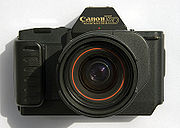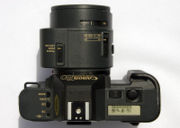
Canon T80
Encyclopedia


Canon Inc.
is a Japanese multinational corporation that specialises in the manufacture of imaging and optical products, including cameras, camcorders, photocopiers, steppers and computer printers. Its headquarters are located in Ōta, Tokyo, Japan.-Origins:...
's first autofocus
Autofocus
An autofocus optical system uses a sensor, a control system and a motor to focus fully automatic or on a manually selected point or area. An electronic rangefinder has a display instead of the motor; the adjustment of the optical system has to be done manually until indication...
35mm
135 film
The term 135 was introduced by Kodak in 1934 as a designation for cartridge film wide, specifically for still photography. It quickly grew in popularity, surpassing 120 film by the late 1960s to become the most popular photographic film format...
single-lens reflex camera
Single-lens reflex camera
A single-lens reflex camera is a camera that typically uses a semi-automatic moving mirror system that permits the photographer to see exactly what will be captured by the film or digital imaging system, as opposed to pre-SLR cameras where the view through the viewfinder could be significantly...
. It was introduced in April 1985 and discontinued in June 1986 and is part of the T series
Canon T series
Canon's T series is Canon's final series of manual focus 35 mm single lens reflex cameras. The first camera, the T50, was introduced in March 1983 while the final camera, the T60, was released in April 1990. All have a Canon FD lens mount compatible with Canon's extensive range of manual-focus...
of FD mount
Canon FD
The Canon FD lens mount is a physical standard for connecting a photographic lens to a single-lens reflex camera body. The standard was developed by Canon of Japan and was introduced in March 1971 with the Canon F-1 camera. It was the primary Canon SLR lens mounting system until 1987 when the...
cameras, and is not compatible with Canon's later EOS
Canon EOS
The Canon EOS autofocus 35 mm film and digital SLR camera system was introduced in 1987 with the Canon EOS 650 and is still in production as Canon's current DSLR system...
system and its autofocus EF-mount
Canon EF lens mount
Introduced in 1987, the EF lens mount is the standard lens mount on the Canon EOS family of SLR film and digital cameras. EF stands for "Electro-Focus": automatic focusing on EF lenses is handled by a dedicated electric motor built into the lens...
lenses. Instead, three special lenses, designated AC, were produced for the camera. Other FD-mount lenses could also be used, but without autofocus capabilities.
Autofocus
The autofocus system in the T80 works in the same manner as the focus assist system built into the earlier AL-1Canon AL-1
The Canon AL-1 was an FD mount, 35mm single-lens reflex camera introduced in March 1982. Its main feature was the "Quick Focus" focus-assist system that was aimed at those who had trouble focusing through the viewfinder—either novices, or those with poor eyesight—and was intended to...
. A linear CCD is used to detect contrast in the focus area. When this area has the maximum contrast, the lens is in focus. This is a similar mechanism to that used in compact digital camera
Digital camera
A digital camera is a camera that takes video or still photographs, or both, digitally by recording images via an electronic image sensor. It is the main device used in the field of digital photography...
s. When a manual focus lens is used, the camera provides focus assistance in exactly the same manner as the AL-1.
The autofocus lenses contained a motor, and electrical contacts in the lens mount connected this motor to the camera's circuits.
Auto exposure and scene modes
Except for its autofocus capability, the T80 was very similar to the earlier T70Canon T70
The Canon T70 was a 35mm FD-mount single-lens reflex camera introduced in April 1984 as the second in Canon's T series. The T70 started with the concepts explored in 1983's T50, took them further, and applied them to a more sophisticated camera...
, with four programmed scene modes in addition to regular Program auto-exposure (AE). These were:
- Deep Focus - the camera chooses a narrow aperture in order to get more depth of fieldDepth of fieldIn optics, particularly as it relates to film and photography, depth of field is the distance between the nearest and farthest objects in a scene that appear acceptably sharp in an image...
. Useful for landscapes, or other situations when the photographer needs to get everything in reasonable focus. Trades off against a slow shutter speed. - Shallow Focus - the camera chooses a wide aperture to get a shallow depth of field. Useful for portraiture, to reduce background distractions.
- Stop Action - the camera chooses a fast shutter speed so that movement is stopped. Useful for sports, wildlife, children etc.
- Flowing - the camera chooses a longer shutter speed for deliberate motion or panning blur.
- Program - the camera has more freedom of choice. Tends to prefer reasonably quick shutter speeds for minimal blurring.
Film transport
Film transport in the T80 was completely automatic, just as in the T70, in both directions. This left the top of the camera very clean, since there was no advance lever or rewind knob. Film loading was automatic; the user only had to align the film leader with an orange mark and close the back, and the camera loaded and advanced the film automatically. Indicators on the top LCDLiquid crystal display
A liquid crystal display is a flat panel display, electronic visual display, or video display that uses the light modulating properties of liquid crystals . LCs do not emit light directly....
displayed the status of loading, winding and rewinding. The motor, and the camera's other functions including the focussing motor in the lens, were powered by 4 AAA batteries housed in the base of the camera.
AC lenses
Three special autofocus AC lenses were produced for the T80. Each lens contained a motor to focus, unlike the body-integral AF system pioneered by MinoltaMinolta
Minolta Co., Ltd. was a Japanese worldwide manufacturer of cameras, camera accessories, photocopiers, fax machines, and laser printers. Minolta was founded in Osaka, Japan, in 1928 as . It is perhaps best known for making the first integrated autofocus 35mm SLR camera system...
. All are readily identifiable by a boxy area on the upper left (viewed from the camera) containing the motor, and a red ring around the front lens element. The lenses were:
- AC 50mm f/1.8
- AC 35-70mm f/3.5-4.5
- AC 75-200mm f/4.5
All three, like the T80 itself, were only produced for a short time and are rare. The auto-focus function does not work on any other camera, although they can be used as manual-focus FD lenses. However they lacked aperture rings, so they were only useful on FD camera bodies that could control the aperture from the body.
There was one other Canon FD autofocus lens, the Canon New FD 35-70 mm f/4 AF
Canon New FD 35-70 mm f/4 AF
The Canon FD 35-70mm 4 AF lens of 1981 was Canon's first attempt at adding autofocus capability to their range of single-lens reflex cameras. Canon took their existing, successful Canon FD 35-70mm f/4 lens and added a box above the lens which housed a self-contained autofocus mechanism, Canon's SST...
. This had been introduced in 1981, and used a similar autofocus system to the T80's lenses, with an integral autofocus motor. The lens had a self-contained autofocus system that did not require autofocus electronics in the camera body.
Canon, unlike Minolta and Nikon
Nikon
, also known as just Nikon, is a multinational corporation headquartered in Tokyo, Japan, specializing in optics and imaging. Its products include cameras, binoculars, microscopes, measurement instruments, and the steppers used in the photolithography steps of semiconductor fabrication, of which...
, was convinced that having the motor in the lens was the optimal approach; this line of thinking continued with the new EOS system in 1987, which remains Canon's standard mounting system today.
Data back
A Command Back 80 was available for the T80. Like the similar back available for the T90Canon T90
The Canon T90, introduced in 1986, was the top of the line in Canon's T series of 35 mm Single-lens reflex cameras. It was the last professional-level manual-focus camera from Canon, and the last professional camera to use the Canon FD lens mount...
, it supports date stamping of images, alphanumeric coding of images, time exposures and time-lapse interval exposure.

